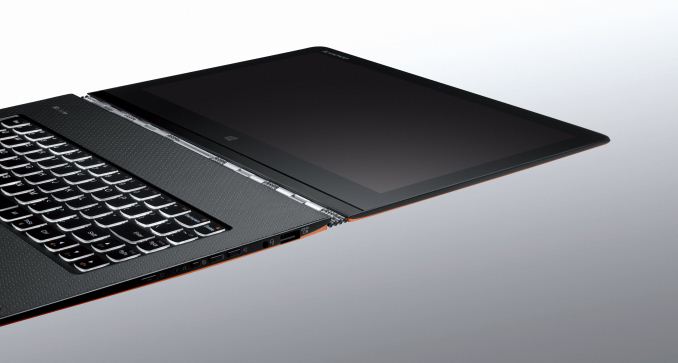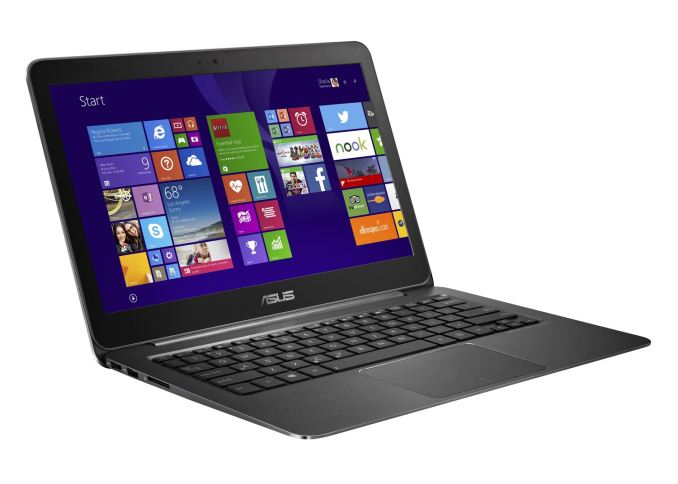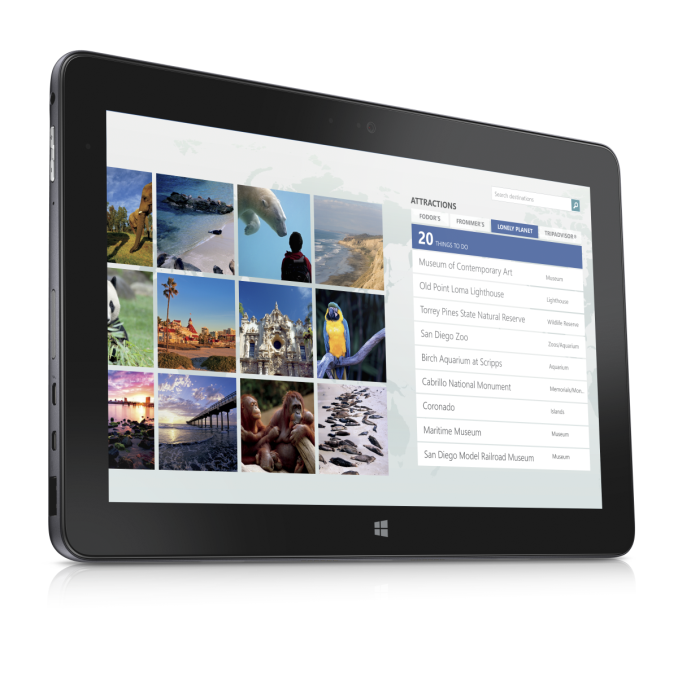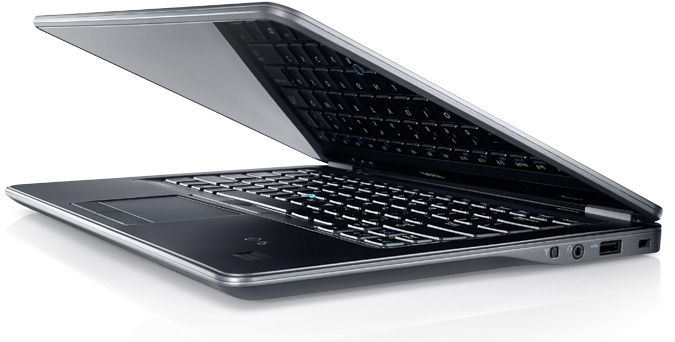Analyzing Intel Core M Performance: How 5Y10 can beat 5Y71 & the OEMs' Dilemma
by Brett Howse & Ian Cutress on April 8, 2015 8:00 AM ESTThe Devices and Test
For today's article we have run a sampling of devices through several benchmarks which vary in workload substantially. Some are single-threaded and some are multi-threaded - some emphasize burst performance, and some focus on sustained performance. Some involve the GPU and some do not. During all of the benchmarks, CPU frequencies, GPU frequencies, and processor temperature were logged. The devices are all different as well, and offer different takes on Core M.
The first device is the Lenovo Yoga 3 Pro. This is the same device that we reviewed, and it features a Core M-5Y71 processor which is the very top of the Core M range. Lenovo has chosen to include a fan, so this is the only one of the Core M devices being included that is actively cooled. Being a convertible laptop, Lenovo must be more wary of surface temperatures than a traditional laptop since the Yoga 3 Pro can be used in the hand as a tablet.
The second device is the ASUS Zenbook UX305, which was recently reviewed as well. This features a Core M-5Y10 processor, which is the lowest-end model available. The UX305 is passively cooled and features an entirely aluminum chassis, which helps to dissipate the heat generated. As a laptop, higher surface temperatures can be manageable since the device is normally sitting on the raised feet and not in direct contact with skin.
The third device is the Dell Venue 11 Pro 7000, which also features the top end Core M-5Y71. This is a tablet first and foremost, and is also passively cooled. The Venue features a plastic rear casing, and as a tablet surface temperatures must be taken into consideration.
The final device is the Dell Latitude 14 7000, which is powered by the Core i5-5200U processor. Being a much higher TDP part, but largely the same architecture, will give a reference point on what Broadwell will do when given better cooling. The sample received has only one channel of memory, which will mostly affect the GPU scores. Dell does offer dual-channel memory, so this device can perform higher than the sample that we have.
Overall the Core i5-5200U is much less dynamic than Core M, with a base CPU frequency of 2.2 GHz and boost of 2.7 GHz. If you will notice, the boost is actually less than the Core M-5Y71, so assuming adequate cooling, or short enough workloads, Core M could in theory outperform the i5, which is something we did see on some benchmarks in the Yoga 3 Pro review.
The average computing day for anyone is going to be wildly different depending on what tasks they are performing. A lot of tasks however are very much burst workloads. As an example, browsing the web means loading the page, which is mostly done upfront. These kinds of workloads will play well into what Core M can do. Boost up to the maximum frequency, get the work done, and then fall back down to the base frequency and cool off. This is the epitome of Intel's hurry up and get idle philosophy.
However not every workload is like this. Gaming for example is a lot of consistent work, done over a long period of time, so cooling is the key here to keep performance up.
To sample a wide variety of workloads, I have picked a variety of benchmarks which are both short and long, do burst work or sustained work, and some involve the GPU and others do not.
Cinebench R15 Single-Threaded: This benchmark performs rendering on a single CPU core, so it should showcase higher clock speeds and good single-threaded performance. The benchmark lasts roughly ten minutes.
Cinebench R15 Multi-Threaded: The same benchmark, but the work is performed on all available cores, including hyper-threading. This benchmark is roughly three minutes.
PCMark 8 Home and Creative: Both the Home and Creative suites of PCMark 8 feature a variety of workloads. Home includes workloads for web browsing, writing, gaming, photo editing, and video chat. Creative includes web browsing, photo editing, video editing, group video chat, media transcoding, and gaming workloads. Home is around thirty minutes, and Creative takes about an hour to complete.
TouchXPRT 2014: This benchmark performs beautify photos (add filters, HDR, etc), blend photos, convert videos for sharing, create music podcast, and create slideshow from photos. Each task is timed, and a lower time results in a higher score. This benchmark takes about ten minutes to finish.
3DMark Sky Diver and Cloud Gate: 3DMark is a staple of our reviews. Both run through several graphics and physics tests which work both the CPU and GPU. Sky Diver is the more difficult of the tests. Sky Diver is about five minutes, and Cloud Gate is about three minutes.
3DMark Ice Storm Unlimited: This test is completely off-screen, and allows for comparison of the graphics across devices and even platforms. Being that it is available for smartphones and tablets, it is a much lower demand on the GPU, and completes very quickly on a PC with the entire benchmark being complete in about a minute.
DOTA 2: This incredibly popular online multiplayer battle-arena game is our final benchmark. This is the same workload performed for the DOTA 2 benchmark we have for reviews, only we run it for the full length of the recording. The entire run is around 45 minutes.
The following pages are very graph heavy, with some of the graphs being quite wide to show the sustained performance of the device over the benchmark run. Below is a gallery of all of the images, in order, which can be references as larger images in a separate window.
A note about the graphs. Each benchmark will show an entire run on each device, and then some combined graphs with the individual scores compared against the other devices. Due to the sampling rate, it may appear that some devices finished the benchmark before the others, but this is not always the case. Several of the devices were too loaded to always log to the text file, so they may have less entries, and appear to get the work done quicker if just comparing based on the time scale. The important data on the combined graphs is how each device handles the entire workload versus the others. We have also included the scores from each device to see where they finish the benchmark.




















110 Comments
View All Comments
maxxbot - Wednesday, April 8, 2015 - link
If the device buyer's choice is between the Core M and an ARM or Atom they're going to go with the Core M because it's faster in every aspect, especially burst performance. If the Core M in unacceptable slow for you then there aren't any other options at the 4.5W TDP level to turn to, it's the best currently available.name99 - Wednesday, April 8, 2015 - link
That ("Maybe Intel made too many compromises") seems like the wrong lesson.I think a better lesson is that the Clayton Christensen wheel of reincarnation has turned yet again.
There was a time more than 40 years ago when creating a computer was a demanding enough exercise that the only companies that could do it well were integrated top to bottom, forced to do everything from designing the CPU to the OS to the languages that ran on it.
The PC exploded this model as standardized interfaces allowed different vendors to supply the BIOS, the OS, the CPU, the motherboard, the storage, etc.
BUT as we push harder and harder against fundamental physics and what we want the devices to do, the abstractions of these "interfaces" start to impose serious costs. It's no longer good enough to just slap parts together and assume that the whole will work acceptably. We have seen this in mobile, with a gradual thinning out of the field there; but we're poised to see the same thing in PCs (at least in very mobile PCs which, sadly for the OEMs, is the most dynamic part of the business).
This also suggests that Apple's advantage is just going to keep climbing. Even as they use Intel chips like everyone else, they have a lot more control over the whole package, from precisely tweaked OS dynamics to exquisitely machined bodies that are that much more effective in heat dissipation. (And it gets even worse if they decide to switch to their own CPU+GPU SoC for OSX.)
It's interesting, in this context, where the higher frequency 1.2GHz part is difficult for some vendors to handle, to realize that Apple is offering a (Apple-only?) 1.3/2.9GHz option which, presumably, they believe they have embodied in a case that can handle its peak thermals and get useful work out of the extra speed boost.
HakkaH - Friday, April 10, 2015 - link
Device buyers don't even see beyond the price tag, brand name and looks. 90% of the people who buy tech are pretty oblivious on what they are buying. So they wouldn't even know if a device would throttle the speed at all.Secondly I'd rather have a device that throttles good which processors are doing the last couple of years than have a steady pace at which it just crawls along and maybe after 5 minutes decides... hey maybe I can add 200 MHz and still be okay. If that is your case I bet you still have the first generation smartphone in your pocket instead of a more recent model because they all aggressively throttle the CPU and GPU in order to keep you from throwing your phone out of your hands ;)
HP - Saturday, August 8, 2015 - link
Your description doesn't follow the usage paradigm of most computing tasks. As the user is actively using their device what they do on the machine roughly tracks the user's thought patterns which largely takes place in series. He doesn't batch the tasks in his head first and then execute them. So race to sleep is where it's at.milkod2001 - Wednesday, April 8, 2015 - link
What about Intel's native 4 core mobile CPUs. Are any in the works?Core M,Y, U(2 core) etc might be OK for bloggers, content consumers etc but if one wants/needs real performance on the go, there's not that much new to offer, right?
nathanddrews - Wednesday, April 8, 2015 - link
I think we'll have to settle for the i7-4700 until Skylake. Not a bad place to settle.kpkp - Wednesday, April 8, 2015 - link
"Atom competed against high powered ARM SoCs and fit in that mini-PC/tablet to sub 10-inch 2-in-1 area either running Android, Windows RT or the full Windows 8.1 in many of the devices on the market."Atom in Windows RT? Wasn't RT ARM only?
Essence_of_War - Wednesday, April 8, 2015 - link
Very impressed by the Zenbook, especially at its price point.boblozano - Wednesday, April 8, 2015 - link
Thanks for the detailed article.In this space it's clear that the top design consideration is cooling - do that well, and everything else follows. Performance will be delivered by the SoC's ability to turbo as needed, power consumption by the SoC and the rest of the design.
Of course materials, size, the question of passive vs. active cooling ... all that also factors decisively into the success of a design, whether the target market actually buys the devices.
But the effectiveness of the cooling will largely determine performance.
Refuge - Wednesday, April 8, 2015 - link
The efficiency of the cooling too. Can't have it take up too much space or too much power (If active and not passive)otherwise you leave either no room for your battery, or you drain it too fast keeping the thing cool (In the case of active)